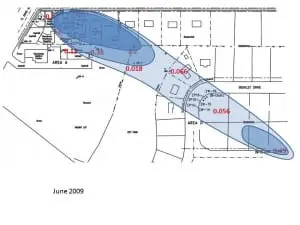Pesticide Bioremediation with Petrox®
Site Summary
Petrox® bioremediation was used to remediate dieldrin and other pesticides at a site in Pensacola, Florida. The remediation progressed in stages including a bench-scale treatability study and field pilot study prior to full-scale remediation. The full-scale remediation is also staged to take full advantage of the benefits of each application of Petrox® bioremediation prior to the next application. The remediation is in progress, but this case study reports the significant progress made in reducing the size of the impacted ground water plume and the contaminant concentrations.
Geology and Hydrogeology
The site is located on coastal plain sediments. The sediments are fine to medium-grained quartz sand to approximately 40 feet deep, where a medium to coarse grained sand layer is encountered. The coarse-grained layer is approximately five feet thick. The coarse-grained layer overlies a fine to medium-grained sand layer with interbedded discontinuous clay lenses. The sediments form a thick, unconfined aquifer. The water table is at approximately 45 feet below grade.
Contamination
Chlorinated pesticides were used at the site from 1982 to 1984. The release is assumed to be from the accumulation of small spills during on site mixing operations. The impacted soil was located on the property and concentrated in a drainage swale. The pesticides leached from the soil into the ground water forming a plume that was approximately 2,000 feet long and 200 feet wide. Soil source removal was conducted in August 2005 when a total of 1,272 tons of soil were excavated and disposed off-site. Bioremediation was selected to remediate the residual impacted soil and ground water.
Remediation
Petrox bioremediation was applied to the on-property source area and a mid-plume down gradient area. The down gradient plume treatment area was at a set of three injection wells 425 feet from the source area and up gradient from a cluster of monitoring wells.
Three full-scale applications of bioaugmentation were completed. The initial application in November 2011 was 1,540 gallons of Petrox solution injected into soil and 7 seven injection wells in the source area, and 3 mid-plume injection wells near the CW-13 well cluster. The injection in February 2012 was 990 gallons of Petrox solutions in 6 source area wells and 3 down gradient wells near the CW-13 wells. The third injection was 330 gallons of Petrox solution in the same 3 down gradient wells.
Following Petrox® bioaugmentation the source area dieldrin concentrations were reduced from a maximum of 9.9 µg/L to 0.47 µg/L. The down gradient treatment reduced the dieldrin concentrations over an area of more than one acre by at least 90%. Overall the size of the plume was reduced by about one half and concentration by 90% in less than one year.



